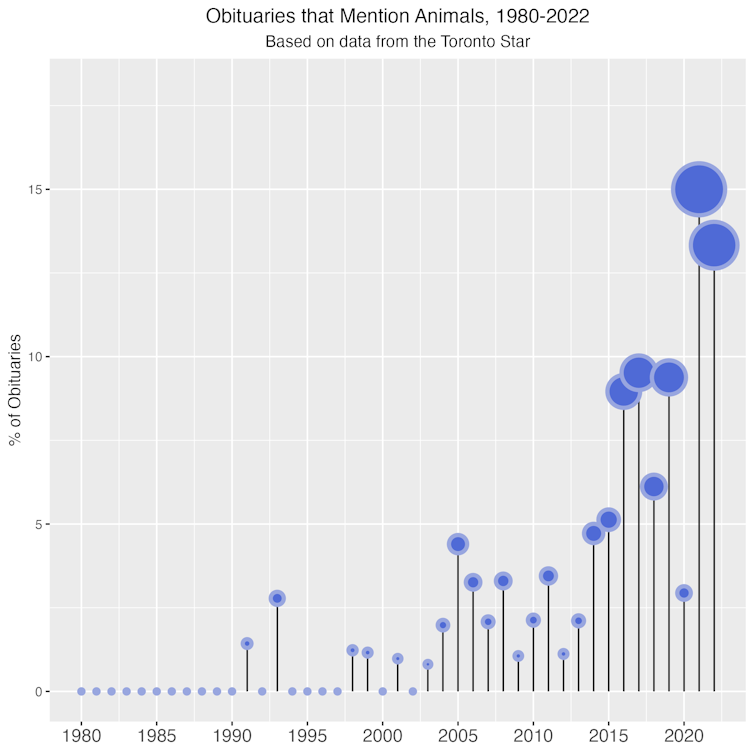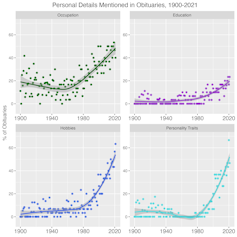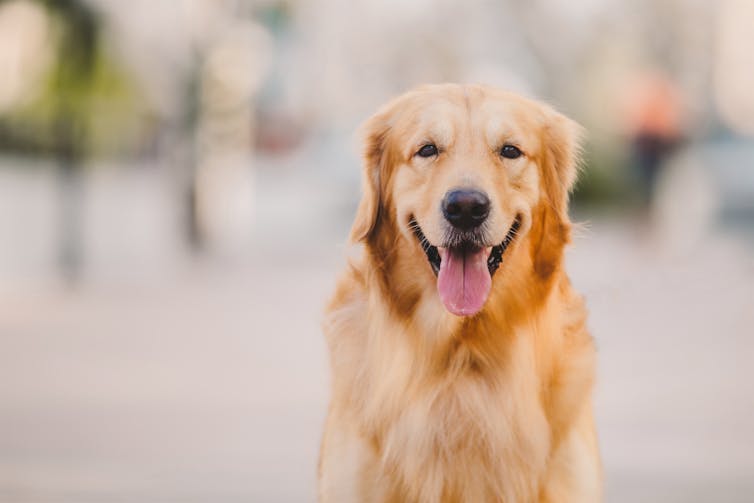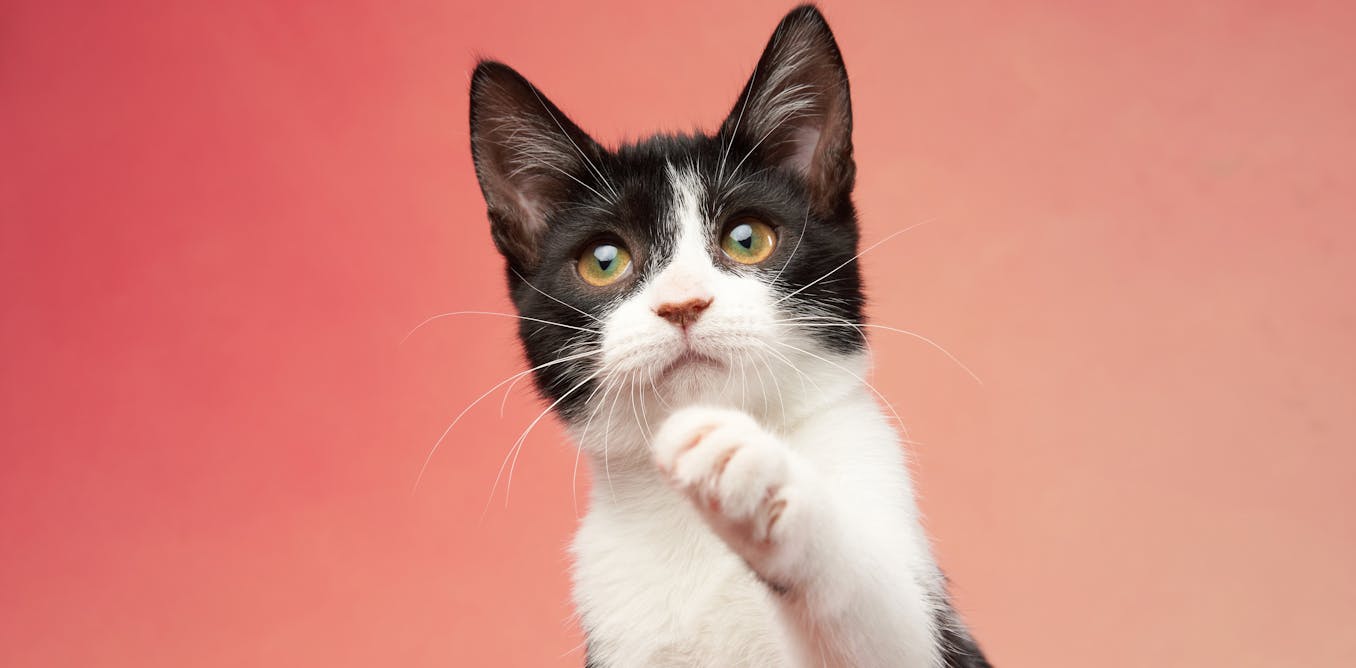[ad_1]
Animals occupy many alternative roles in our lives. Some contemplate them family members, whereas others admire the reminder to take every day walks.
From service canine and emotional help animals to the pet ready to greet us on the entrance door, animals can deliver pleasure, consolation and companionship to our lives. So naturally, these relationships that type all through our lives would proceed — or no less than be commemorated — in dying.
The Toronto Star just lately reported on efforts to excavate and transfer over 600 animals from an Oakville, Ont. pet cemetery. As that story highlighted, and as many others will be aware, burying, embalming or cremating animals is hardly a brand new apply. These funerary practices provide methods to honour a pet and every little thing they meant to us.
However what about when the proprietor dies first? Because it seems, animals are extra ceaselessly getting talked about within the obituaries of their human companions.

From service canine and emotional help animals to the pet ready to greet us on the entrance door, animals can deliver pleasure, consolation and companionship.
How obituaries are altering
Writing an obituary is without doubt one of the many practices individuals conduct when a cherished one dies. Previously, they had been reserved for society’s elite, however the democratization of the obituary has resulted in additional individuals being memorialized on this approach.
We write obituaries for various functions. A few of these are purely sensible; to announce that somebody died, or invite household and mates to the funeral.
Extra importantly although, obituaries give the bereaved an opportunity to inform a narrative about somebody they cherished. Who had been they? What did they get pleasure from? What had been their values?
As one of many research inside the Nonreligion in a Advanced Future mission, our crew has analyzed Canadian obituaries over the past century to grasp transformations in how individuals commemorate the lifeless. Because it seems, animals are showing extra ceaselessly with every passing 12 months.
As just lately as 1990, not a single one of many 53 obituaries printed on a given Saturday within the Toronto Star talked about any pets. This steadily began to vary, nonetheless. We study that, in 1991, Harriet shall be “sadly missed by all of her mates and animals.” Likewise, Berton — who died in 1998 — was “sadly missed by his ‘good boy Scamp.’”
By the mid-2000s, roughly one to 4 per cent of obituaries talked about pets. Since 2015, this quantity has climbed as excessive as 15 per cent.

The p.c of obituaries from the Toronto Star between 1980–2022 that point out pets or animals. Based mostly on a pattern of all obituaries printed on a given Saturday.
Granted, these figures should not precisely overwhelming. In a pattern from 1980 to 2022 containing 3,241 obituaries, solely 79 point out animals. Nonetheless, this minor uptick factors to a change in how individuals compose obituaries.
Telling private tales
Our analysis reveals that, because the early 1900s, obituaries have grown progressively longer. The previous commonplace was quick notices stating the deceased’s title, age and the place they died — all within the house of about 4 strains. Lately, the imply size has grown to round 40 strains, with some reaching over 100 strains.
This added house leaves room for extra details about the deceased. For instance, over 80 per cent of latest obituaries point out the deceased’s kids. That is up from about 50 per cent previous to 1960.
Current obituaries are additionally extra prone to point out the deceased’s schooling, occupation or hobbies. Past simply itemizing attributes, it’s common to see wealthy, detailed descriptions. Somewhat than be outlined by their job title, we learn that one man was “a devoted visionary who remained happy with and dependable to his many staff and colleagues.”

Our furry mates
As obituaries develop longer and extra detailed, it solely appears honest that animals get some consideration. It has turn out to be extra widespread to say somebody’s pet, or love of animals. Passages additionally develop extra detailed. Past the pet’s title, we study whether or not they had been a “hoity-toity poodle,” a “loyal companion” or “the perfect canine ever.”
Occupation is one other staple of obituaries. For Mary, who died in 2019, a profession spotlight whereas working at Nestle Purina was “inducting varied heroic pets and repair canine into the Purina Corridor of Fame.” Not only a skilled ardour; Mary additionally had six black Labradors at residence.
Hobbies and pursuits have gotten extra widespread in dying notices. For Bobby, these included “sitting in his backyard along with his canine, Chloe” and “being entertained by his beloved parrot, Pookie.”
Somewhat than ship the household flowers, many obituaries now shut by requesting donations within the deceased’s reminiscence. Unsurprisingly, teams just like the Humane Society, the Farley Basis and varied nature conservancy teams are rising in recognition.

It has turn out to be extra widespread to say somebody’s pet or their love of animals of their obituary.
The brand new methods we grieve
This development in dying notices hints at a broader societal shift. Particularly, persons are putting larger worth on nature and non-human animals. The explanations behind this flip are different and sophisticated. However the proof — in obituaries and past — suggests persons are discovering significant connection via the pure world and with other-than-human creatures.
Animals apart, obituaries additionally reveal vital transformations in how we commemorate the lifeless. These had been as soon as temporary, formulaic texts (and a few nonetheless are). However extra ceaselessly, obituaries are home windows into the lifetime of an individual. They are often unhappy or tragic, but additionally humorous, sarcastic and heartwarming.
Above all, obituaries at the moment are extra private. To commemorate the lasting reminiscence of somebody they cherished, households wish to share with the world what made that particular person particular. This may be informed via the actions, individuals or pets that introduced them pleasure all through their lives. For some, this implies cheering for his or her favorite hockey crew, or recalling the time they scored a hole-in-one, and, typically, the furry pal they curled up with on the finish of a protracted day.
[ad_2]
